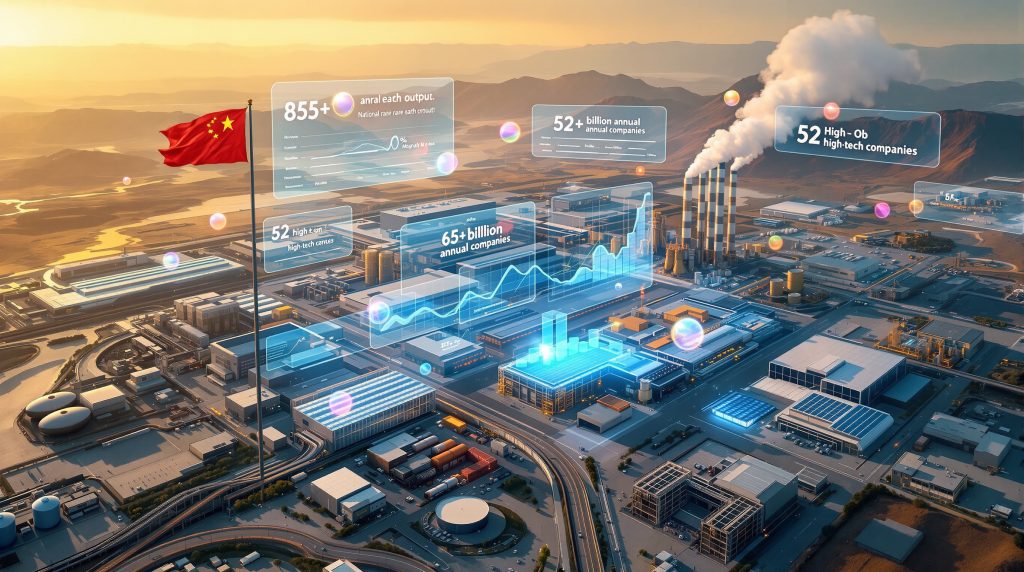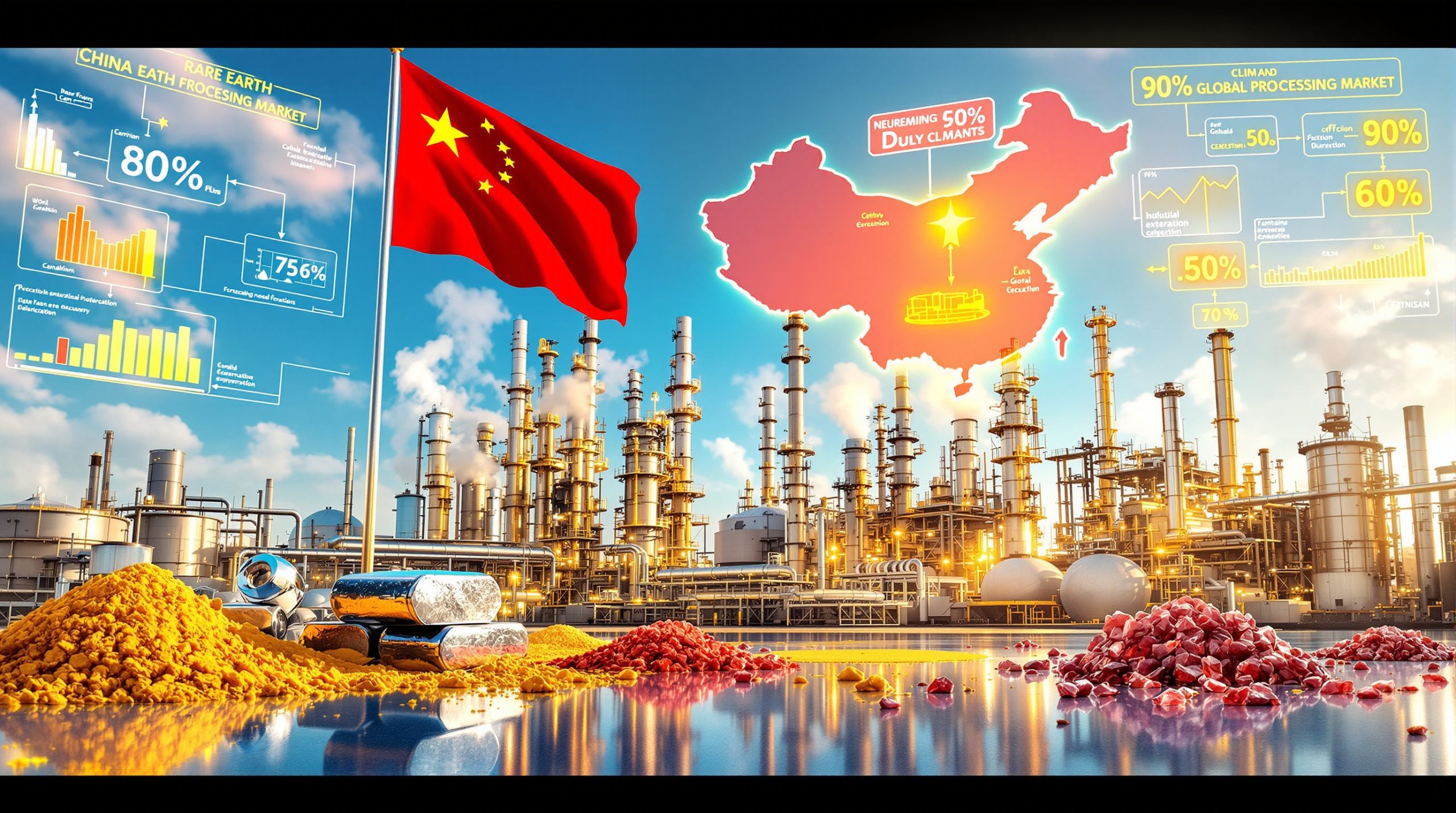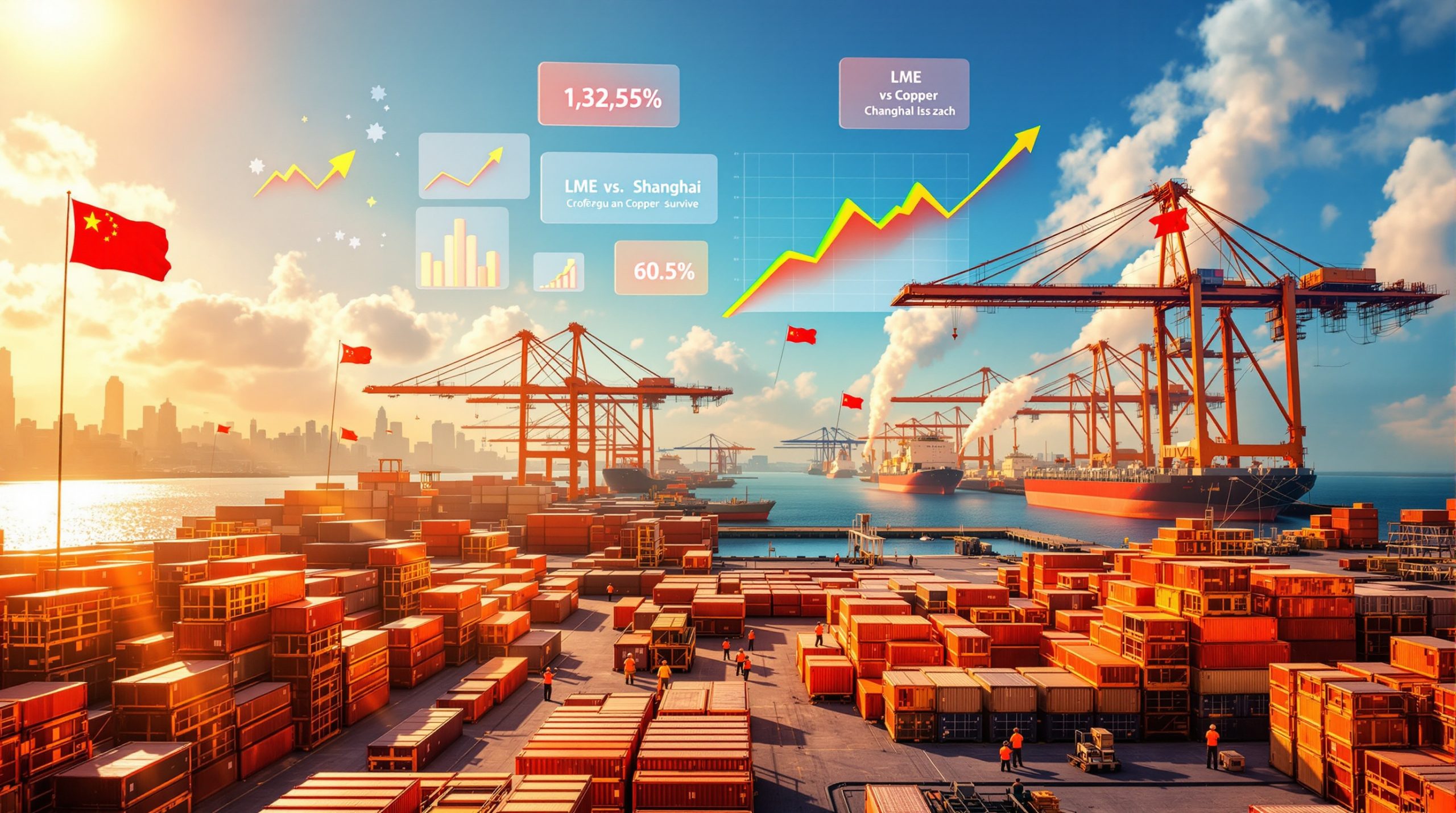Strategic Geographic Advantages and Resource Proximity
Baotou's emergence as China's rare earth hub stems from exceptional geographic positioning within Inner Mongolia's mineral-rich landscape. The city serves as Inner Mongolia's second-largest urban centre, strategically located near one of the planet's most significant rare earth deposits. Furthermore, this positioning reflects broader trends in mining industry evolution across critical materials sectors.
The proximity to Bayan Obo mining operations creates unprecedented advantages for rare earth processing. This massive deposit contains more than 40% of the world's known rare earth element reserves and generates nearly half of global rare earth production, according to NS Energy Business analysis. Such concentration of resources within a single geographic region enables integrated supply chain development that competitors struggle to replicate.
Transportation infrastructure connecting extraction sites to processing facilities eliminates costly logistics challenges faced by geographically dispersed operations. The regional ecosystem supports seamless material flow from raw ore through refined concentrates to finished products, creating efficiency gains that strengthen competitive positioning in global markets.
Industrial Transformation Driving Global Markets
Evolution from Raw Materials to Advanced Manufacturing Excellence
Baotou China's rare earth hub has undergone remarkable transformation from basic ore extraction to sophisticated manufacturing operations. The region's evolution demonstrates how strategic industrial planning can capture maximum value from natural resource endowments. However, this transformation aligns with global sustainable mining transformation initiatives addressing environmental concerns.
Modern processing facilities now convert rare earth concentrates into high-value products including permanent magnets, specialised alloys, and advanced functional materials. This vertical integration allows local manufacturers to control quality throughout the production chain while reducing dependency on external suppliers for critical components.
The manufacturing ecosystem encompasses multiple industrial parks designed to support different stages of rare earth processing. These facilities coordinate operations to minimise waste streams while maximising output efficiency across the entire production network.
The National Rare Earth High-Tech Zone Framework
China established a dedicated national-level technology development zone in Baotou to coordinate rare earth industry advancement. This framework provides regulatory clarity and investment incentives specifically tailored to critical materials processing and manufacturing. Consequently, this approach differs from European initiatives establishing a CRM facility in Europe to reduce dependency on Chinese processing.
The zone operates as an integrated ecosystem where research institutions collaborate with manufacturing enterprises to develop next-generation rare earth applications. Technology transfer mechanisms facilitate knowledge sharing between academic researchers and commercial producers, accelerating innovation cycles.
Government support through the zone framework includes preferential policies for high-technology enterprises engaged in rare earth functional materials development. These incentives encourage private sector investment in advanced manufacturing capabilities rather than traditional extraction-focused operations.
Economic Impact on China's Rare Earth Strategy
Production Capacity and Market Dominance
Baotou China's rare earth hub generates substantial economic value through integrated manufacturing operations. The region's processing capacity handles significant portions of global rare earth production, creating economic multiplier effects throughout Inner Mongolia's industrial base. In addition, this concentration supports the broader critical minerals energy transition requirements globally.
Local conversion rates demonstrate the region's success in capturing value-added manufacturing rather than exporting raw materials. This approach generates higher-skilled employment opportunities while building technological capabilities essential for maintaining long-term competitive advantages.
The concentration of rare earth processing in Baotou supports China's position controlling approximately 85% of global rare earth processing capacity. This market dominance provides strategic leverage in international technology supply chains while generating substantial export earnings.
Manufacturing Concentration and Industry Leadership
Major magnetic material enterprises have established headquarters and production facilities in Baotou to capitalise on proximity to rare earth feedstock supplies. This industrial clustering creates knowledge spillovers and specialised labour markets that benefit the entire regional economy.
The concentration effect enables smaller enterprises to access specialised services, equipment, and expertise that would be unavailable in dispersed locations. Suppliers of processing equipment, analytical services, and logistics support have developed robust local business networks supporting the rare earth industry ecosystem.
Strategic positioning within China's industrial system allows Baotou-based manufacturers to serve both domestic and international markets efficiently. Export-oriented production benefits from streamlined regulatory processes whilst domestic sales support China's clean energy and advanced technology sectors.
Inner Mongolia's 10-Year Development Plan Transform
Comprehensive Critical Minerals Strategy (2025-2035)
Inner Mongolia's recently announced development plan extends through 2035 with comprehensive objectives for critical minerals sector advancement. The strategy emphasises building a solid ecological security barrier whilst accelerating rare earth functional materials development. Baotou set to become China's rare earth hub under Inner Mongolia's 10-year plan outlines these ambitious objectives.
Key plan components include:
• Making comprehensive progress on protection and integrated use of critical minerals
• Launching new strategic mine-exploration initiatives
• Accelerating high-end rare earth functional materials development
• Optimising application structures and spatial layouts for critical minerals
• Enhancing resource utilisation efficiency across operations
The plan represents a strategic evolution from extraction-focused development to sustainable, technology-driven growth that maintains environmental standards whilst expanding productive capacity.
Infrastructure and Ecological Integration
Environmental considerations receive prominent attention in the development framework, reflecting growing awareness of sustainability requirements for long-term industry viability. The solid ecological security barrier concept indicates systematic approaches to environmental protection throughout the mining and processing value chain. Furthermore, these initiatives complement mine reclamation innovations being developed globally.
Spatial layout optimisation suggests coordinated planning between extraction sites, processing facilities, and manufacturing operations to minimise environmental impact whilst maximising operational efficiency. This integrated approach addresses historical concerns about environmental degradation associated with rare earth processing.
Resource utilisation efficiency improvements target waste reduction and circular economy principles. Advanced separation technologies and byproduct recovery systems can transform waste streams into valuable secondary products, improving overall economic and environmental performance.
Role in Global Supply Chain Security
Strategic Vulnerability for International Markets
Baotou China's rare earth hub represents a critical dependency point for global technology manufacturing. International industries requiring rare earth materials face concentrated supply risk given the region's dominant processing capacity and integrated production systems.
According to Rajiv Biswas, CEO of Asia-Pacific Economics research firm, "the strategic initiative to develop Baotou into an integrated rare earths supply-chain hub will further strengthen China's position as the world's leading rare earth producer. Large-scale new investment in magnets using rare earth materials at Baotou will strengthen China's global leadership in magnet production for electric vehicles and wind turbines for renewable energy."
This concentration creates potential vulnerabilities for industries dependent on steady rare earth supplies. Electric vehicle manufacturers, wind turbine producers, and defence contractors face supply chain risks if geopolitical tensions or operational disruptions affect Baotou's production capacity.
Technological Innovation and Competitive Advantages
The integrated approach combining mining, refining, and advanced manufacturing within a single industrial complex creates efficiency advantages that competing regions find difficult to replicate. Coordinated operations reduce lead times, transportation costs, and quality variability compared to geographically dispersed supply chains.
Green processing initiatives address environmental concerns whilst maintaining cost competitiveness. Advanced separation technologies reduce waste generation and improve recovery rates for valuable rare earth elements, supporting both environmental and economic objectives.
Quality control systems ensure consistent product specifications across the entire production network. Standardised processes and centralised technical oversight enable reliable supply relationships with international customers requiring precise material properties.
Global Industries Dependence on Operations
New Energy Sector Requirements
The clean energy transition drives substantial demand for rare earth materials processed in Baotou China's rare earth hub. Electric vehicle production requires high-performance permanent magnets for motor applications, whilst wind turbine generators depend on rare earth magnets for efficient power generation.
Renewable energy infrastructure deployment accelerates global demand for rare earth functional materials. Solar panel manufacturing, energy storage systems, and grid stabilisation equipment incorporate rare earth elements in critical components affecting performance and reliability.
Market growth in new energy applications creates sustained demand for Baotou's production capacity. The region's integrated manufacturing capabilities position it to serve expanding global markets whilst supporting China's domestic clean energy objectives.
Technology Sector Dependencies
Consumer electronics manufacturing relies on rare earth materials for miniaturised components, high-performance displays, and advanced battery technologies. Inner Mongolia to make Baotou China's largest rare earth materials hub highlights the strategic importance of this industrial concentration.
Telecommunications equipment requires rare earth elements for signal processing, optical components, and electromagnetic shielding applications. Advanced computing systems incorporate rare earth materials in memory devices, processors, and cooling systems.
Data centre infrastructure depends on rare earth elements for power management, electromagnetic compatibility, and thermal regulation applications. Military and aerospace applications utilise rare earth materials for guidance systems, communication equipment, and advanced materials requiring extreme performance characteristics.
Environmental Challenges and Solutions
Sustainability Initiatives and Green Technology
Baotou China's rare earth hub addresses environmental challenges through comprehensive sustainability initiatives targeting waste reduction and ecological protection. Historical environmental concerns associated with rare earth processing have prompted development of cleaner production technologies and stricter regulatory oversight.
Toxic byproduct management systems implement advanced treatment technologies to neutralise hazardous materials generated during rare earth separation processes. Containment protocols prevent contamination of soil and groundwater resources whilst ensuring worker safety throughout operations.
Water treatment facilities upgrade capabilities to handle increased processing volumes whilst meeting environmental discharge standards. Closed-loop systems recycle process water to minimise consumption and reduce environmental impact from rare earth processing operations.
Future-Focused Environmental Solutions
Carbon footprint reduction strategies incorporate renewable energy sources into processing operations. Solar and wind power integration reduces reliance on coal-fired electricity whilst demonstrating commitment to sustainable development principles.
Circular economy initiatives transform waste streams into valuable secondary products through advanced recovery technologies. Thorium and uranium byproducts can be processed for nuclear applications whilst other waste materials serve as feedstock for construction materials or chemical products.
Ecosystem restoration projects in mining areas demonstrate long-term environmental stewardship commitments. Revegetation programmes, soil remediation, and wildlife habitat restoration address cumulative environmental impacts from decades of mining operations.
Impact on Global Rare Earth Competition
Market Dynamics and International Response
Baotou China's rare earth hub dominance influences global market dynamics and prompts international supply diversification efforts. Western nations recognise strategic vulnerabilities in rare earth supply chains and invest in alternative production capacity development.
Alternative rare earth projects face significant challenges competing with Baotou's integrated production systems and cost advantages. Mountain Pass operations in California, Lynas facilities in Australia, and emerging projects in Africa struggle to achieve comparable scale and efficiency.
Price volatility management through Chinese production control affects global rare earth markets and downstream industries. Strategic stockpiling initiatives by importing countries attempt to buffer supply disruptions but cannot fully eliminate dependency on Chinese processing capacity.
Innovation Leadership and Technological Gaps
Advanced processing technology development in Baotou creates widening technological gaps between Chinese capabilities and international competitors. Research and development investment concentration provides sustained innovation advantages in rare earth separation and purification technologies.
Manufacturing efficiency improvements through automation and process optimisation establish new industry benchmarks for productivity and quality. International competitors require substantial technology transfer or independent research investments to achieve comparable performance levels.
Quality standardisation across product lines enables reliable supply relationships with demanding international customers. Consistent material properties and delivery reliability create competitive advantages that extend beyond simple cost considerations.
Future Developments Strengthening Position
Expansion Plans and Capacity Growth
Baotou China's rare earth hub expansion plans target increased processing capacity and expanded product portfolios to serve growing global demand. Additional processing facility construction will enhance production flexibility whilst maintaining cost competitiveness in international markets.
Advanced materials research centres under development will accelerate innovation in rare earth applications for emerging technologies. Collaboration between research institutions and commercial enterprises will drive next-generation product development for clean energy and advanced manufacturing applications.
International partnerships and joint venture opportunities enable technology transfer whilst expanding market access. Strategic alliances with downstream manufacturers create integrated value chains extending from rare earth processing through finished product manufacturing.
Strategic Market Positioning
New energy transition material supply leadership positions Baotou to benefit from accelerating global clean energy deployment. Electric vehicle market growth, renewable energy expansion, and energy storage development create sustained demand for rare earth functional materials.
Global magnet manufacturing hub consolidation concentrates production capabilities in Baotou whilst serving international markets through efficient export systems. Specialised manufacturing capabilities support both standardised products and customised applications for demanding industrial customers.
Technology transfer and licensing opportunities generate additional revenue streams whilst strengthening relationships with international partners. Intellectual property development in rare earth processing and applications creates long-term competitive advantages extending beyond raw material supply.
Disclaimer: This analysis is based on publicly available information and industry reports. Rare earth market conditions, geopolitical factors, and technological developments may affect future outcomes. Readers should conduct independent research and consult qualified professionals before making investment or strategic decisions related to rare earth markets.
Baotou China's rare earth hub continues evolving as a critical node in global technology supply chains. The region's integrated approach to rare earth production, processing, and manufacturing creates competitive advantages that extend far beyond traditional cost leadership. As international markets increasingly depend on rare earth materials for clean energy transitions and technological innovation, Baotou's strategic importance will continue growing, significantly influencing global economic and strategic relationships for decades to come.
Ready to Capitalise on Critical Mineral Discoveries?
Discovery Alert's proprietary Discovery IQ model delivers real-time alerts on significant ASX mineral discoveries, instantly empowering subscribers to identify actionable opportunities ahead of the broader market. Understand why major mineral discoveries can lead to significant market returns by exploring Discovery Alert's dedicated discoveries page, showcasing historic examples of exceptional outcomes, and begin your 30-day free trial today to position yourself ahead of the market.




